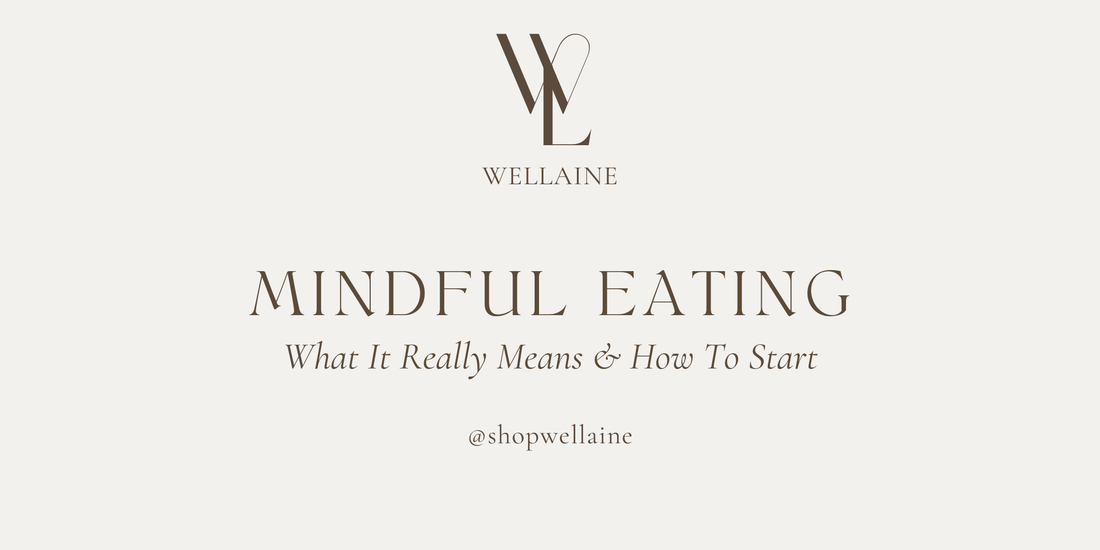
Mindful Eating | Transform Your Relationship With Food
Share

We've all had those days where you finally sit down to eat, but you're answering emails, scrolling through your phone, watching the latest episode of your current show on Netflix, or thinking about the next thing you need to do from your to-do list right? And then, before you know it, the food’s gone...and you can’t even remember tasting it. Then comes the crash: bloating, fatigue, or that nagging feeling that you're still hungry.
The truth is, it’s probably not just a busy lifestyle causing the disconnect. It’s also misinformation. We’re taught to reach for quick fixes that satisfy cravings or give us an instant boost, rather than supporting what our bodies are genuinely asking for.
Years ago, when I was deep in adrenal fatigue from Lyme disease and burnout from overworking, I thought caffeine was my lifeline. In reality, my body needed rest, minerals, and nourishment from whole foods – not another cup of coffee.
When we are in a rush, cooking meals from scratch isn’t always an option so we turn to store-bought foods that look healthy, but are unfortunately far from it. Packages promise “natural,” “whole grain,” or “low-fat” options, yet hide sugars, artificial dyes, and preservatives that keep us coming back for more. Many of these foods are designed to be addictive, overriding our natural hunger cues and making it harder to trust ourselves around food.
Mindful eating is how we take back that trust. It’s not a diet or a set of rules–it’s about slowing down, tuning into your body’s natural signals, listening to what you body is genuinely asking you for, and nourishing yourself with intention.
WHY MINDFUL EATING MATTERS EVEN MORE TODAY
The way we eat has changed more in the past few decades than it has in centuries. Highly processed, calorie-dense, and nutrient-poor foods are everywhere. They’re often cheaper, faster, and more tempting than fresh, whole options. Add in the constant distractions of modern life, and it’s no wonder so many of us eat on autopilot and look at it as we reward system.
The problem is, when we’re not fully present, we’re more likely to eat past fullness, choose foods that spike and crash our blood sugar, and ignore the subtle cues our body gives us about what it actually needs. Over time, this disconnect can affect digestion, energy levels, mood, and even our relationship with food.
Mindful eating helps rebuild that connection. It’s not about perfection–it’s about creating enough space in your day to listen, notice, and respond in a way that feels purposeful rather than reactive.
STEP ONE: EAT WITH YOUR SENSES
So often, we tend to eat on autopilot, barely noticing the food in front of us. But when you intentionally bring your senses into the experience, eating becomes instantly more satisfying, and you’re less likely to overeat or miss your body’s fullness cues.
Before your first bite, pause for a moment. LOOK at the colors and textures on your plate. SMELL the aromas rising from your food. These scents actually prime your body for digestion by signaling your brain to release digestive enzymes. As you take a bite, FEEL the texture. Is it crisp, creamy, tender, chewy? Slow down enough to TASTE each flavor. Is it sweet, salty, bitter, savory, sour? Notice how they change as you chew. Even the subtle SOUNDS of eating, like the crunch of a vegetable or the sizzle of something fresh off the pan can ground you in the moment.
This doesn’t have to mean dragging out every meal for an hour. Even adding 1-2 minutes of sensory focus at the start of eating can help your brain register pleasure and satisfaction more fully. Over time, this simple shift can make it easier to tell when you’re actually full, reduce mindless snacking, and help you enjoy your meals without eating more food.
STEP TWO: LEARN TO TELL THE DIFFERENCE BETWEEN EMOTIONAL AND PHYSICAL HUNGER
It’s easy to confuse true hunger with the many emotions and situations that make us want to eat. Physical hunger builds gradually, is felt in your stomach, and can be satisfied by a variety of foods. Emotional hunger, on the other hand, often comes on suddenly, feels urgent, and tends to crave very specific foods—usually the ones that bring quick comfort.
Emotional eating can be triggered by sadness, anger, loneliness, stress, tiredness, or boredom—all perfectly human feelings we experience throughout the day. Even happy moments can blur the lines: excitement, nostalgia, or celebration often come with food at the center. And then there’s socializing—birthday cake when you’re already full, snacking on endless appetizers while chatting, or saying yes to “just one more bite” because everyone else is still eating. In those moments, food is about connection, comfort, or participation—not necessarily what your body physically needs.
The goal here isn’t to judge yourself or to eliminate eating in these moments. It’s about building awareness so you can make a conscious choice instead of letting habits or emotions drive it automatically. Try asking yourself:
- Am I truly hungry, or is something else like an emotion, fatigue, or the current situation making me want to eat?
- If I weren’t feeling this way or in this environment, would I still want this food right now?
Noticing the difference is a gentle first step towards building a relationship with food that’s rooted in trust and self-care.
STEP THREE: SUPPORT YOUR DIGESTION
Digestion isn’t just about what you eat, it’s about how you eat. The process starts before your first bite, when the sight, smell, and anticipation of food trigger your brain to send signals to your stomach, pancreas and salivary glands to begin releasing digestive enzymes. If you rush through a meal, you short-circuit this chain reaction.
When food isn’t broken down properly in your mouth, when digestion actually begins, it forces your stomach and intestines to work harder often leading to bloating, gas, sluggishness, and even nutrient malabsorption. Eating too quickly can also cause blood sugar spikes sharply, which may be followed by an energy crash, mood changes, and renewed cravings. Slowing down helps counteract all of this. Things to try:
- Pausing before starting to eat: even 30 seconds can help your nervous system shift into ‘rest and digest’ mode
- Chewing thoroughly: aim for at least 15-20 chews per bite so food reaches your stomach in a partially digested form
- Resting between bites: put down your fork, take a sip of water or tea, or engage in brief conversation before continuing
These habits give your digestive system the time it needs to do its job well–breaking down food efficiency, absorbing nutrients, and letting you feel naturally full and satisfied without overeating. Over time, eating at a calmer pace can improve not just digestion, but also energy, mood, and long-term gut health.
STEP FOUR: KEEP A FOOD-MOOD JOURNAL
One of the most powerful tools for mindful eating is also a pretty simple one: writing things down.
A food-mood journal isn’t about calorie counting or strict tracking. It’s about building awareness and spotting patterns between what you eat, how you feel, and the circumstances surrounding your meals. When you take note not only what you ate but also how you felt before and after, you start to see important connections:
- Certain foods that leave you feeling energized verse sluggish
- Times of the day when you’re more likely to snack out of boredom or stress
- Emotional triggers that send you looking for comfort foods
- Social settings where you eat far more or far less than usual
The goal isn’t perfection or judgement – it’s insight. Over time, these observations help you make more intentional choices. For example, if you notice that processed snacks leave you crashing mid-afternoon, you can plan to have a protein-rich option on hand instead. If you see that late-night eating disrupts your sleep, you might shift your dinner time to be earlier. To keep it simple, try jotting down:
1. Time and place of your meal or snack
2. What you ate (without obsessing over measurements)
3. Your hunger level before eating (on a scale of 1-10)
4. Your mood or emotions before and after eating
5. Any physical sensations after eating - energized, bloated, focused, sluggish, etc
Even a few words can be enough. The key is consistency. In just a couple of weeks, you’ll start to see patterns you may never have noticed before, and with them, opportunities to nourish yourself in ways that truly support your energy, mood, and long-term health.
BRINGING IT ALL TOGETHER
Mindful eating isn’t about rigid rules—it’s about reclaiming your ability to truly listen to your body. By eating with your senses, distinguishing between emotional and physical hunger, supporting your digestion, and tracking your food–mood patterns, you begin to rebuild trust in yourself and your natural hunger cues.
In a world where processed, addictive foods and constant distractions pull us away from that connection, these small but intentional shifts create space to pause, breathe, and choose what will actually serve you—physically, mentally, and emotionally.
Sometimes, nourishing yourself also means slowing down with rituals that ground you. For many of us, a warm cup of herbal tea can be that moment of pause. It’s something that supports digestion, eases stress, and creates a mindful break in the middle of a busy day. Our Adaptogenic Herbal Tea Blend was created for exactly that: a gentle, mineral-rich way to replenish and restore while inviting you to be fully present.
So the next time you sit down for a meal or make yourself a cup of tea, give yourself permission to be there for it. No screens, no multitasking, just you, your senses, and the food or drink in front of you. Over time, you’ll find that mindful eating doesn’t just change the way you eat—it changes the way you feel in your body, your energy, and your life.

